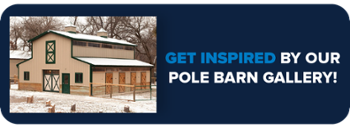Cost | Repairs & Renovations | Building Design | Wainscoting
Can You Add Wainscoting to an Existing Pole Barn?
Meet Addy, FBi's Marketing Content Creator. With a BFA in Graphic Design, she blends her passion for creativity into our brand.
When considering building repairs and renovations, wainscoting is certainly an option worth exploring. And what’s not to love about wainscoting? This charming building feature is aesthetically pleasing, easy to repair, and relatively inexpensive.
Wainscoting adds a touch of character and elegance to any space, and since change is a natural part of life, it's perfectly understandable that you want to update your older post-frame building.
In this blog, we’ll discuss the process and cost of adding wainscoting to an existing pole barn, helping you enhance its look and functionality.
How Much Does Pole Barn Wainscot Cost?
The cost of adding wainscot to an existing post-frame building can range from $58 to $78 per linear foot, including materials and labor.
On a new construction project, wainscotting averages around $4.50 per lineal foot, because all of the labor costs are figured into the total building cost.
5 Steps: How to Add Wainscoting to an Existing Post-Frame Building
1) Understanding Wainscoting
What is wainscoting? You may have heard the term before, and you may have seen it too, but possibly, you were unsure of what to call it. Wainscotting is a common feature found on pole barns. It’s a steel strip, usually standing at three to four feet in height, installed along the lower section of the building.

Commonly, wainscoting serves as a popular choice among homeowners and interior designers seeking to elevate ordinary walls.
Is there historical significance? Of course! In fact, it was originally used to keep moisture out of stone homes, with the additional benefit of providing insulation.
Nowadays, wainscoting is more of an ornamental piece rather than a wall covering, available in a variety of patterns and heights.
There are still a couple of added benefits. Wainscoting offers practical advantages, such as easy replacement of damaged sections. In the event of accidental impact or damage, only the bottom portion needs replacing, which comes at a relatively low cost.
If you’re looking for materials that include brick, stone, and assorted siding options, you can request a quote from your professional builder.
2) Planning Your Project
Here’s the exciting part – your pole barn design is up to you. Planning your project involves assessing your building's architecture and style, selecting the appropriate type of wainscoting, and choosing colors that harmonize with your space.
 Architecture
Architecture
Start by evaluating the architecture and style of your pole barn. Architecture can be defined as the art and science of designing buildings. Consider its elements, such as the roof pitch, siding material, and overall aesthetic. Seeing the bigger picture can help you choose wainscoting materials and styles that complement the existing structure seamlessly.
Materials
Pole barn wainscoting typically involves metal or Versetta stone materials due to their durability and weather resistance. Metal wainscoting offers a sleek and modern look, while Versetta stone provides a rustic charm.
Before making a decision, consider the practical aspects of each material, such as maintenance requirements and compatibility with your climate. Both of these materials are known to be tough against weather.
Cost is another factor, and rough cost ranges for metal and Versetta stone are listed below.
| Stone | $90 - $95 per LNFT |
| Metal | $4.50 - 5.00 per LNFT |
Color
When selecting colors for your pole barn wainscoting, take cues from the primary building materials and color palette. Aim to match or complement the existing siding, roof, and trim colors to create a unified appearance. Color samples and consultations with professionals can help ensure an accurate color match. Achieving visual harmony between the wainscoting and the existing building is essential for a cohesive look. These color combination tips can be helpful.
3) Preparing for Installation
Site preparation is an important step, but you won’t need to level out the ground as if this were a new construction project.
 For this building renovation, you’ll want to make sure that the area is clear of equipment and clean. Be sure to inspect the walls for any damage. In some cases, a rotted column could need to be repaired.
For this building renovation, you’ll want to make sure that the area is clear of equipment and clean. Be sure to inspect the walls for any damage. In some cases, a rotted column could need to be repaired.
Most importantly, you’ll need to carefully measure the dimensions of the walls where you plan to install the wainscoting. Take precise measurements to determine the amount of materials needed, including the metal panels, trim pieces, and other accessories.
Use these measurements to create a detailed plan for the installation, noting any obstacles or irregularities that may need special attention.
4) Installation Process
Installing wainscoting to an existing building can be done in a few key steps.
- Cut the Bottom 3 Feet: Carefully cut the bottom 3 feet of the existing steel panels. The cut might not be perfectly straight, so take your time and use appropriate cutting tools.
- Install a 2x6 Support: Attach a 2x6 board around the middle to provide a sturdy attachment point for the top of the new steel panels and the bottom of the cut steel.
- Add Z-Trim for Transition: Place Z-trim at the transition between the old and new steel to create a clean and finished look.
- Mount Panels: Begin installing the new panels from one end of the wall, working your way to the other end. Ensure each panel is level and properly aligned before securing it.
- Secure Panels: Use screws, nails, or other fasteners to attach the panels to the wall. Ensure the fasteners are evenly spaced and flush with the surface.
5) Finishing Touches
Once the panels are in place, install any trim pieces around the edges, corners, and along the top and bottom of the wainscoting. Ensure that all of the panels are secured properly, and make any necessary adjustments or repairs.
Once this has been completed, you’ve successfully renovated your building with a new wainscotting addition.
Ultimately, adding wainscot to an existing building can run anywhere from $58 - $78 per lineal foot. The components that lead to this cost include:

- Mobilization cost to get the crew and equipment out to the job site
- Labor to remove the existing steel siding
- Labor to cut the existing steel siding to fit above the new wainscot
- Material & labor to install a new 2x6 girt at the 3’ height
- Material & labor to install new z-trim on that 2x6 girt
- Labor to re-install the existing steel siding above the new z-trim
- Material and labor to install new steel 3’ tall on the bottom below the z-trim
- Dumpster cost to dispose of the existing cut-off steel siding
- Clean-up on the job site and demobilization
Side Note: Incorporating wainscotting into a new construction project doesn't significantly increase the overall cost. Since the steel is typically already factored into the building price, the additional expenses mainly entail z-trim and labor for installing a second run of steel siding. For reference, the cost of adding a wainscot to a new build averages around $4.50 per lineal foot of wainscot.
Are You Ready to Renovate Your Existing Post-Frame Building?
At FBi Buildings, our Repair & Renovation Specialists will help you navigate the building process to get the best bang for your buck.
We’ll also tell you a secret: it doesn’t matter who built the original pole barn. We’ll repair or renovate ANY post-frame building!
Are you ready to get started on your pole barn addition? Please call our office at (800) 552-2981, and we’ll gladly give you a FREE renovation quote.
Do you have more questions about wainscoting that are not covered in this article? If you need help designing and planning, please contact FBi Buildings at 800.552.2981 or click here to email us. If you're ready to get a price, click here to request a quote, and a member of our Customer Engagement Team will help you determine the next steps of your project.




